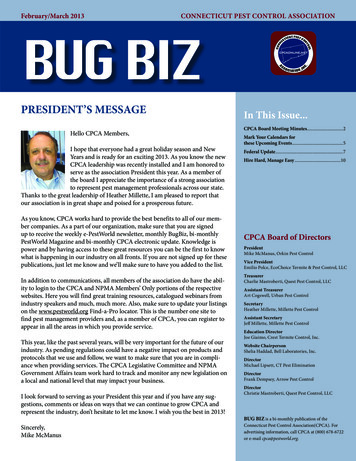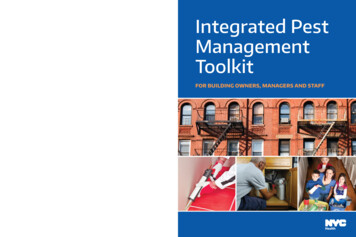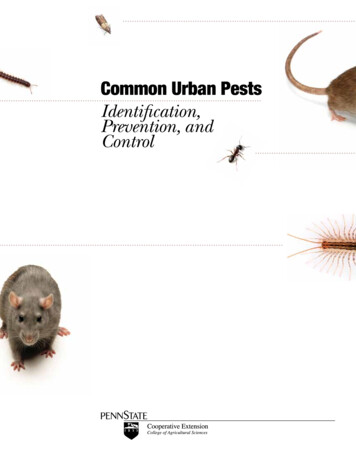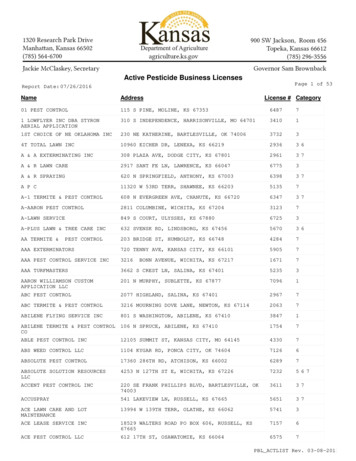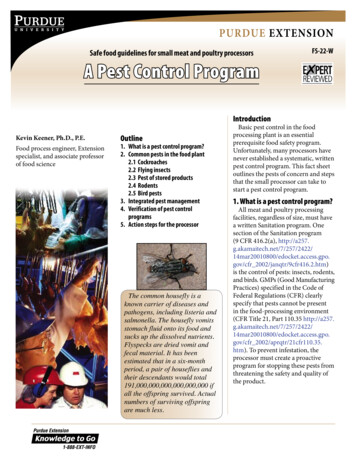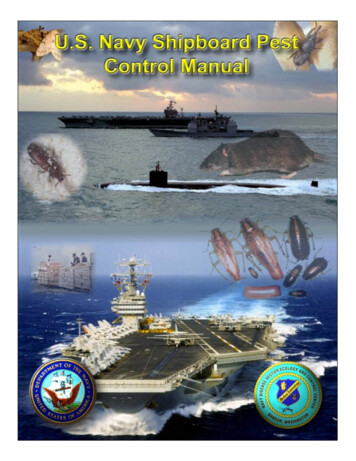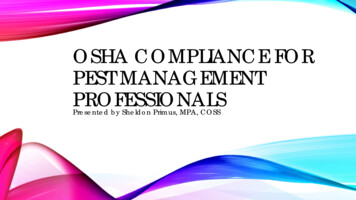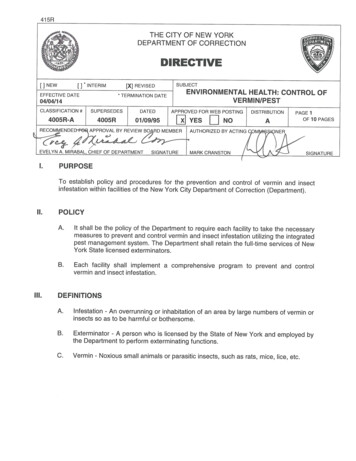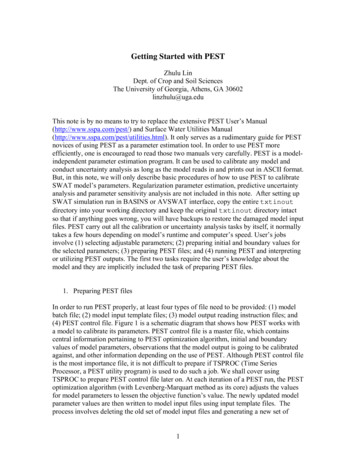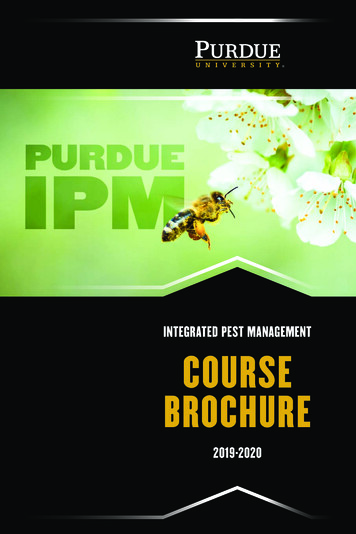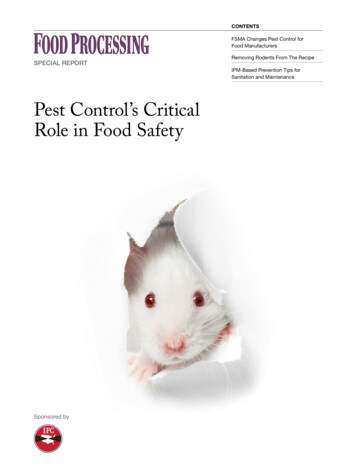
Transcription
CONTENTSFSMA Changes Pest Control forFood ManufacturersSPECIAL REPORTRemoving Rodents From The RecipeIPM-Based Prevention Tips forSanitation and MaintenancePest Control’s CriticalRole in Food SafetySponsored by
Fo o d Pro cessin g: SPECIAL REPORT“Old-fashioned fence line baitingFSMA Changes Pest Control forFood ManufacturersThe Food Safety Modernization Act and Global Food Safety Initiativeaudits make processors rethink their pest management programs.deficiencies that create pest andindustry are increasingly influencedtion of pest-sighting logs as part ofment regulations. Between theFood Safety Modernization Actand third-party audits that complywith the Global Food Safety Ini-cient flexibility to allow rodenticideprotection for the diverse kinds offacilities and outdoor storages foodprocessors utilize,” he says.GFSI-recognized programsbetter pest management programs.p Pest management programs inby food safety audits and govern-but the current labels have suffi-are another huge motivator forBy Dave Fusaro, Editor in Chiefthe food and beverage processingis prohibited unless within 100 ft.,microbial harborages and utiliza-pest management trend analysis,”says Jerry Heath, product managerand staff entomologist for Indus-trial Fumigant Co., Lenexa, Kan.Rodent management is one ofIn some ways, GFSI may havemore impact on pest control thanFSMA. While FSMA considerspest control a general recommendation of a HACCP program, allthe GFSI-recognized programshave very specific requirements forpest control.One change, thanks to mosttiative (GFSI), there are more rulesthose areas that has seen someprograms certified by GFSI, is theAnd a lot more record-keeping.packaging, distribution and labelsdevices. Most pest managementand more prescribed steps to follow.FSMA applies to virtually everyfood & beverage processor in thecountry. In a 2013 note in theFederal Register, the FDA notedsignificant changes. Rodent baitwere revised in 2011 in response toconcern for exposures to childrenand non-target animals.“Mitigation of non-target animalthat problems with both pests andexposure had the most impactsafety incidents in the recent past.Heath continues. “Label revisionspesticides were contributors to foodPest control has always been apart, although largely implied, offederal food safety requirements, atleast since the 1938 Federal Food,Drug & Cosmetic Act. In a read-ing of the January 2013 expansionof FSMA, “Pest management inthe future will pay heightenedattention to product transport vehicles, loading dock and non-foodstorage areas, facility maintenanceon the food processing industry,”in 2011 limited most outdoorrodenticide placements to withinplacement and spacing of rodentprograms prior to the 2013 changesfollowed a formula, placing themevery so many feet, but most popular audit standards compliant withGFSI now allow for more flexibledevice placements based on knownthreats, ongoing inspection andhistory of activity.“There have been examples where50 ft. of buildings. A number ofnumbers of rodent control devicesEPA’s directive and, in remarkablyand pest management service hasshortcomings were identified infast action, the labeling directivewas revised to within 100 ft. ofbroadly defined structures. Rodenticides with this new labeling wereon the market by late 2012.www.Food P roc e s s i ng.c om- 2-have been dramatically reduced,evolved to a more general inspection routine,” says Heath.But many facilities in the foodand beverage industry are still governed by audit standards requiringa formula-based device placement
Fo o d Pro cessin g: SPECIAL REPORTscheme — or the plants lack trend-shut down of whatever work area isto be sure management notifica-in device numbers. So it’s best toetrates all cracks and crevices andtaken if there are multiple rodentis allowed. Also, many facilities arethat every bug in the room is dead.ing data to support a reductioncheck with your auditors for whatjust more comfortable with a conservative program.Correct and efficient identifi-cation of pests is the first step tosolving any pest challenge. Today,pest control experts are turningmore and more to digital technol-ogy, specifically digital microscopesand digital photos as a reliablebeing fumigated. Fumigation pen-provides a high degree of certaintyBut it also penetrates packagingmanagement techniques for thesebromide, probably the most popular fumigant, a few years back.Other effective chemicals also havebeen removed.For fogging, chemicals areprovide a quick kill, but dissipateapproaches have their proponents.Neither leaves any residual chemi-cal on surfaces, which in most casesis a benefit but does not providelong-term killing power.Fumigation probably is a moreeffective method, but it requires aThere is common knowledgethe EPA, which de-listed methylhas been dealt some setbacks byinside the plant, processors shouldfumigation and fogging. Botha foothold.about many aspects of rodentsprayed in controlled areas. Thereconsider the debate betweencaptures or risks of rodents gainingand machines. Fumigation alsomeans for pest identification.For widespread pest controltions and appropriate responses areis less penetration. The chemicalsmore rapidly than fumigation,so downtime is greatly reduced.Sequential fogging treatments caneliminate or reduce the frequencybiology that contributes to ourpests. We know they can enterthrough small holes of only ¼ - ½inch in size, so doors need to closetightly and holes leading intopotential harborages need to besealed. We know rodents tend totravel along floor-wall junctionswhich dictates many trap and baitstation placements. We know thatmice are more curious than rats andthus easier to trap.Let’s examine some lesserof fumigations.known aspects of rodent biologydone by pest control personnel ormore advanced strategies. FoodHeath notes that fogging can beby a fixed fogging system. pand behavior and consider somefacilities are often large, sprawlingcomplexes with potential risksfrom rodents indoors and out. Butrodents will typically only utilizeRemoving Rodents FromThe Recipenarrow travel pathways and smallp Pest management should alwayskind of facility. It is not uncommonallow the most efficient placementstion of key pests and considerationhave some feeding in exterior baitbe approached first with recogniof aspects of their biology wheremanagement options can bebrought to bear. Rodents are recognized as a key threat for everyto trap an occasional mouse orstations, but infestations can neverbe tolerated in or around food facilities. A number of food companieshave escalation protocols in placewww.Food P roc e s s i ng.c om- 3-areas for most of their activity.So, recognizing and inspecting tolocate the most attractive travelroutes and potential harborages canfor traps or outdoor bait stations.The world’s foremost authority onrodent management, Dr. BobbyCorrigan, suggests six words tosummarize this concept: lines,
Fo o d Pro cessin g: SPECIAL REPORTbut rather to discern which of thepotential travel routes in a facilityare actually being used. Regularlyused travel routes or holes willoften feature grey rub marks fromthe oils in rodent fur.Monitoring data proves thatrodent activity is not uniformaround facilities. Most auditstandards, and many food companies allow modification of deviceplacement patterns based on monitoring and risk. Most people canrecognize, for example, that a longblank wall with no openings maynot require the same density ofbait station placements as anotherarea with shipping and receivingshadows, corners, warm spots,droppings or urine spots, and LINES can be wires, pipes, Small animals like rodents arequiet spots and voids.beams, vegetation lines or otherkinds of borders in addition tofloor-wall junctions. Rememberthat rodents are excellent climbers and are active at all levelsof elevation. Rodents are secretive and willtend to prefer shaded, SHADOWY PLACES, or nocturnalactivity. So there may be lighting or warehouse arrangementdesigns that promote bright-ness, or unavoidable shadowingareas ideal for trap or bait station placements. Rodents will tend to pauseat CORNERS, so these areefficient places to inspect forplace traps or bait stations.challenged to maintain bodyheat, so appliances or equipmentthat produce a little heat abovethe ambient temperature can beattractive WARM SPOTS andfor nesting. Sometimes a number of theseattractive features accumulatetogether in the same places thatare also more QUIET than othersurroundings, or in a VOID.The best inspection tool forrodent activity is a good flashlight.Rodents will leave droppingseverywhere they are active. Thebest use for UV inspection lightsis not for scanning trailers, etc.,www.Food P roc e s s i ng.c om- 4-or product risks. It may be prudentto reduce device densities in someareas and increase them in others.Exploit differences in rodent species’ biology, and behavior. Miceand roof rats have nibbling feedinghabits, for example, unlike Norwayrats that will eat a lot at one place.Consider how you might interpretand react to chronic, low-levelactivity in some area. A mouse orroof rat may need to nibble at anisolated station over a number ofdays to accumulate a toxic dose ofbait, but a cluster of closely-spacedstations could encourage nibbleshere and there and achieve a toxicdose much faster. Rodenticide baitsdiffer in their palatability also, soselecting the most palatable baitthat can compete with other foodsources can be a key to success.
Fo o d Pro cessin g: SPECIAL REPORTConsider the differences in pre-earlier the process can begin, theWith nearly forty years of experience,species when it comes to sanitation,grated Pest Management approachin the fields of entomology and pestRodent threats can come fromings, as this proactive approach isindustrial settings. Since 1937, IFCferred habitats of different rodentbetter. Consider upping your Inte-Jerry’s career has focused exclusivelyif you have frequent rodent sight-management in academic and severalthe best way to reduce your risk.is the only national pest managementimportant to help prevent an infes-mologist, is Staff Entomologist servingindustry. For more information, visita broad range of technical servicewww.indfumco.com or call 800-477-time to treat for rodents, so theneeds for IFC’s food industry clients.4432. pexclusion, trapping and baiting.below ground to the roof top!Catching rodent issues early istation from occurring. It can takeJerry Heath, Board Certified Ento-company focused solely on the foodIPM-BASED PREVENTION TIPSFOR SANITATION AND MAINTENANCEEmphasis for pest management is increasingly focused on prevention rather than reaction measures. Of course, one will stillneed to react if some level of infestation is discovered, and it will be best to discover and correct situations as early as possible. Sanitarians often have lead responsibilities for pest control and interface with pest management contractors. Whereas pest management is inter-disciplinary, however, some coordination is needed between sanitation managers and theircounterparts in maintenance, production, and other departments. Teamwork with maintenance, especially, has often beenthe attribute that contributes to excellence in pest management. Harborage elimination and exclusion are two fundamentalelements of Integrated Pest Management (IPM) where maintenance involvement is likely to be necessary.5 PEST PREVENTION TIPS FOR SANITATION1. Inspect and document. Create a“Master Inspection Schedule”if you don’t already have one. Better yet, assemble themanagement team periodically for some of the inspections – perhaps monthly. The value will be to have all the playersinvolved to prioritize needs for corrective actions and downtime.2. Proactive treatments. You probably already know when certain pests will be a challenge – certain invaders in the spring,and others in the fall; stinging insects and Indian Meal Moth (IMM) in the late summer and fall; and so on. Get ahead of thecycles! Schedule outdoor barrier treatments with residual before pressure develops. Get pheromone mating disruptiondevices in place before IMM populations explode. Consider use of grain protectants instead of waiting for inevitable infestations and fumigating. Versatile insect growth regulators (IGR’s) should always be positioned as preventative treatments.3. Be prepared for immediate response to pest discovery. Service providers do their best to respond as soon as pos-sible to calls, but why wait even an hour? Nip little problems in the bud before they escalate. Assemble an emergency kit ofcertain products that can be used in-house to respond immediately to common issues: Mist net for interior bird capture. Virtually invisible to birds, these can be positioned in bird flight paths to quickly entrapbirds that get indoors and resist going back out through a door. Rodent glue paper. Ideal for quickly isolating pallet(s) or an open trailer where a mouse has been spotted or suspected,and trapping when it tries to escape.4. Make the best use of available down time. Down time for deep cleaning is precious! Sweeping floors might not be thebest use of your labor resources when these opportunities present. Use your monitoring data to identify the trouble spotthat needs attention and take action during down town.www.Food P roc e s s i ng.c om- 5-
Fo o d Pro cessin g: SPECIAL REPORT5. Train employees to keep an eye on the facility. The more eyes you have looking for pest activity or conducive con-ditions the better. This is an important benefit of having a pest management service contractor. But, who could be betterfor taking note of insect or rodent activity than employees positioned throughout the facility at all times? Provide sightinglogs where they will be readily accessible to employees. Make it a part of routine pest management service expectations toreview sighting logs and respond appropriately.5 PEST PREVENTION TIPS FOR MAINTENANCEThe value of a maintenance person with some sealant and simple hardware cannot be overstated. Consider the tradeoff between a pest management technician that makes treatments routinely and has certain chronic challenges, and some simplemaintenance work that could solve an exclusion or harborage issue once and for all.1. Fix doors that don’t close properly or have gaps. A tremendous number of insect and rodent issues can be traced tosimple openings to the outdoors. Door openings are the most common culprit, but other openings can be anywhere fromground level up to the roof.2. Seal cracks. Most of the important insect pests spend most of their lives in cracks and crevices. These may beexpansion joints in concrete floors, floor-wall junction cracks, or cracks at the edges of various panels or sheeting materials.Clean cracks out as well as possible, treat with residual insec- ticide and fill with sealant.3. Seal wall penetration holes. Oversized holes where pipes, wires or other utilities pass through walls create harboragesin their own right, and sometimes pathways into wall voids.4. Attend to proper storage of dead equipment and hardware supplies. Hardware supplies and dead equipment –often dirty and in a heap somewhere, is great harborage for insects and rodents. Clean these and cap pipes, etc. Storehardware and equipment in an orderly manner and off the floor or ground.5. Inspect. Think like a bug! Create a list of cracks, holes, and other deficiencies, and track your progress in getting themfixed. Make this an exercise in accomplishing great things with minimum expense rather than a daunting challenge. It maybe helpful to prioritize areas by zones.Jerry Heath, Board Certified Entomologist, is a Staff Entomologist serving a broad range of technical service needs for IFC’sfood industry clients. With nearly forty years of experience, Jerry’s career has focused exclusively in the fields of entomologyand pest management in academic and several industrial settings. Since 1937, IFC is the only national pest managementcompany focused solely on the food industry.www.Food P roc e s s i ng.c om- 6-
NO ADDEDDISTRACTIONS.Call 800.477.4432 or visit indfumco.com for a no obligation facility assessment.
better pest management programs. In some ways, GFSI may have more impact on pest control than FSMA. While FSMA considers pest control a general recommen-dation of a HACCP program, all the GFSI-recognized programs have very specific requirements for pest control. One change, thanks to most programs certified by GFSI, is the

